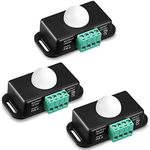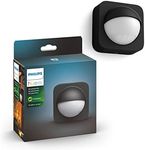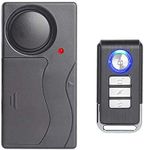Buying Guide for the Best Pir Sensors
When choosing a PIR (Passive Infrared) sensor, it's important to understand how these devices work and what features are most relevant to your needs. PIR sensors detect motion by measuring changes in infrared radiation, which is emitted by objects in their field of view. They are commonly used in security systems, automatic lighting, and various smart home applications. To select the best PIR sensor for your needs, consider the following key specifications and their implications.Detection RangeThe detection range of a PIR sensor refers to the maximum distance at which the sensor can detect motion. This is important because it determines how far away an object can be for the sensor to still detect it. Detection ranges can vary from a few meters to over 20 meters. For small rooms or confined spaces, a shorter range (up to 5 meters) may be sufficient. For larger areas like hallways or outdoor spaces, a longer range (10-20 meters or more) is preferable. Choose a detection range that matches the size of the area you want to monitor.
Field of ViewThe field of view (FOV) of a PIR sensor is the angle over which it can detect motion. This is crucial because it affects how much area the sensor can cover. FOV can range from narrow (less than 90 degrees) to wide (up to 180 degrees or more). For monitoring specific entry points or narrow corridors, a narrow FOV is adequate. For broader coverage, such as in open rooms or outdoor areas, a wider FOV is more effective. Select a FOV that aligns with the layout and coverage requirements of your space.
SensitivitySensitivity refers to how easily the PIR sensor can detect motion. Higher sensitivity means the sensor can detect smaller movements, while lower sensitivity requires more significant motion to trigger detection. This is important for avoiding false alarms or ensuring that even slight movements are detected. If you need to detect subtle movements, such as in a security application, higher sensitivity is beneficial. For environments with a lot of background activity, lower sensitivity can help reduce false alarms. Adjust the sensitivity based on the level of motion you expect in the monitored area.
Power SourcePIR sensors can be powered by batteries, wired connections, or solar energy. The power source affects the installation flexibility and maintenance requirements. Battery-powered sensors are easy to install and can be placed almost anywhere, but they require regular battery replacements. Wired sensors offer a constant power supply but need more complex installation with wiring. Solar-powered sensors are eco-friendly and can be ideal for outdoor use, but they depend on sunlight availability. Choose a power source that fits your installation preferences and maintenance capabilities.
Integration and CompatibilityIntegration and compatibility refer to how well the PIR sensor works with other devices and systems, such as smart home hubs, security systems, or lighting controls. This is important for creating a seamless and efficient setup. Some sensors are designed to work with specific brands or protocols, while others offer broader compatibility. If you already have a smart home system or security setup, ensure the PIR sensor you choose is compatible with it. For new installations, consider sensors that support widely-used standards like Zigbee, Z-Wave, or Wi-Fi for greater flexibility.
Environmental ResistanceEnvironmental resistance indicates how well the PIR sensor can withstand various environmental conditions, such as temperature extremes, humidity, and exposure to dust or water. This is crucial for ensuring reliable performance in different settings. Sensors with higher environmental resistance are suitable for outdoor use or harsh indoor environments, while standard sensors are typically adequate for typical indoor conditions. Assess the environmental conditions of the installation area and choose a sensor with appropriate resistance ratings, such as IP ratings for water and dust resistance.













![Guardline 1320 Foot Long Range Wireless Driveway Alarm [1 Motion Detector Alarm Sensor & 1 Receiver] Weatherproof Outdoor Security Alert System for Home & Property](https://images-proxy.bestreviews.guide/gWZCHYBD2_jvwDrj-qVTgKnZNMo=/0x150/https://m.media-amazon.com/images/I/41JkOntstdL._AC_CX679_.jpg)
![Guardline 1320 Foot Range Wireless Driveway Alarm [4 Motion Detector Alarm Sensors & 1 Receiver] Weatherproof Outdoor Security Alert System for Home & Property](https://images-proxy.bestreviews.guide/mbCaSeZAZ3uHzi5oTr0As_hZuvI=/0x150/https://m.media-amazon.com/images/I/41HAoYDVSGL._AC_CX679_.jpg)

![Guardline 1320 Foot Range Wireless Driveway Alarm [3 Motion Detector Alarm Sensors & 1 Receiver] Weatherproof Outdoor Security Alert System for Home & Property](https://images-proxy.bestreviews.guide/fB1pGO92Qtdkuy9Yw-skfhIJjp8=/0x150/https://m.media-amazon.com/images/I/51suzXBshXL._AC_CX679_.jpg)




